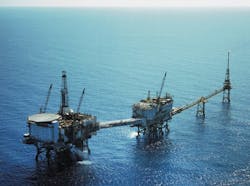Water injection will extend Eldfisk oil through 2017
The new water injection platform, 2/7-E, will be bridge-linked to the field treatment platform at the Eldfisk field center.Phillips Petroleum Company Norway is planning to see in the new millenium by introducing water and gas injection on the Eldfisk Field in the southern North Sea. The new Eldfisk water injection platform, due on stream in January 2000, is also set to become the first in the North Sea to enjoy the environmental benefits of combined cycle power generation.
Last December, Phillips received government approval for its NKr 5.12 billion project and awarded the outstanding main contracts. Orders for some of the long-lead items were placed last summer.
Eldfisk, which was brought on stream in 1979, has been developed with a field center consisting of a wellhead platform, 2/7-A, bridge-linked to a treatment platform, 2/7-FTP. A satellite wellhead platform, 2/7-B, is tied back to this centre, from which processed oil and gas is exported to the Ekofisk complex.
Eldfisk has a chalk reservoir, as does Ekofisk. The latter field, in fact, was the first of this type to undergo water injection, with extremely positive results. Now, Eldfisk production is also expected to benefit substantially from water injection, which according to Phillips and its partners, will add an estimated 177 million bbl of oil equivalent to recoverable reserves, and help extend field life to 2017.
Phillips has been considering the introduction of water injection on Eldfisk for several years, but it is the development of new reservoir models using state-of-the-art technology that has been the main factor in making the project viable, according to project manager Olav Henriksen.
Gas-lift and gas injection facilities will be provided as part of the project, as will additional water injection facilities for Ekofisk. The latter will replace the supplies currently provided by Smedvig from the Ensco 100 (ex West Omikron) jackup under a leasing arangement.
The new platform, designated 2/7-E, will be bridge-linked to 2/7-FTP. It will have water injection capacity of 670,000 b/d - about half of which will be exported to Ekofisk - and gas compression capacity of 1.8 MM cu/meters/day.
The platform will be supplied and installed by Aker Maritime on a turnkey basis. Aker Offshore Partner will perform the engineering, Aker Stord will build the 5,400-ton integrated deck and Aker Verdal the 6,000-ton, four-legged jacket. The platform will be installed by Saipem using its S7000 crane-barge. Modifications on existing platforms will be performed by Aker Offshore Partner.
Seawater will undergo a treatment process to prepare it for injection, including filtration by dual-media filters, sterilization using ultra-violet light and chemicals, and vacuum de-aeration.
Power generation on the platform will be provided by three gas turbines to be supplied by Kv?rner Energy - two LM1600s to drive the Sulzer water injection pumps, and an LM2500 for the gas compression. There will be a single gas train comprising three Nuovo Pignone compressors.
However, the primary electrical power generation will be achieved through a combined cycle system utilizing the waste heat from the gas turbines exhaust - the platform will be one of the first on the Norwegian shelf to use this environmentally friendly technology.
ABB Miljoe will supply both a waste heat recovery steam generator unit and the steam turbine which will turn the heat energy into electricity. The output of this system will be 10.3 MW, sufficient to also make possible the export of power to 2/7-A, 2/7-FTP and to Embla, a small satellite field tied back to the Eldfisk field centre.
The use of combined cycle technology will enable carbon dioxide emissions to be reduced by 52,000 tons/yr compared with a conventional solution. Nitrogen oxide emissions will also be reduced.
By replacing the current power generation on 2/7-FTP, greenhouse gas emissions from the field facilities will be further decreased.
As part of the project, a 14-in water pipeline and a 6-in gas pipeline will be installed over the six km to 2/7-B, and a 25-km, 24-in water line to Ekofisk's dedicated water injection platform, 2/4-K. These lines will be laid by Allseas' layship Lorelay in 1999.
An extensive drilling program is also required. Altogether, 27 horizontal production wells are planned, as well as two cuttings injection wells. One water injector will be newly drilled, as will the single gas injector. The other six water injectors will be conversions of existing producers.
A dedicated well for the re-injection of drill cuttings will be drilled on each wellhead platform - another environmentally beneficial feature, Henriksen says.
The drilling program, which is not scheduled to finish until 2009, will be performed by Smedvig. The contractor will use the modular plug and abandonment (P&A) rig with which, under a separate contract, it is to abandon unused wells in the Ekofisk area. Drilling on Eldfisk with the rig, which is being modified for its new role, begins in mid- 1999.
Water injection operations are due to start in January 2000, followed by gas injection in May 2000 and gas lift in January 2001.
Copyright 1998 Oil & Gas Journal. All Rights Reserved.
